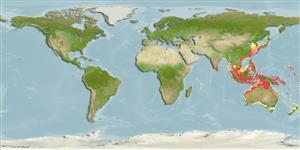>
Anguilliformes (Eels and morays) >
Ophichthidae (Snake eels) > Ophichthinae
Etymology: Ophichthus: Greek, ophis = serpent + Greek, ichthys = fish (Ref. 45335).
More on authors: Jordan & Richardson.
Environment: milieu / climate zone / depth range / distribution range
Ekologi
laut bentopelagis. Tropical
Indo-West Pacific: Taiwan, the Philippines, northern Australia, India, and Myanmar.
Size / Weight / umur
Maturity: Lm ? range ? - ? cm
Max length : 148 cm TL jantan/; (Ref. 123091)
Found on soft bottom, inshore (Ref. 75154); in shallow sand and mud bottom (Ref. 123091).
Life cycle and mating behavior
Maturities | Reproduksi, perkembang biakan | Spawnings | Egg(s) | Fecundities | Larva
Hoese, D.F., D.J. Bray, J.R. Paxton and G.R. Allen, 2006. Fishes. In Beasley, O.L. and A. Wells (eds.) Zoological Catalogue of Australia. Volume 35 Australia: ABRS & CSIRO Publishing, 2178 p. (Ref. 75154)
Status IUCN Red List (Ref. 130435)
ancaman kepada manusia
Harmless
penggunaan manusia
Perikanan: tidak ada kepentingan
Alat, peralatan
laporan khas
muat turun XML
Sumber internet
Estimates based on models
Preferred temperature (Ref.
123201): 22.6 - 29, mean 28 °C (based on 1228 cells).
Phylogenetic diversity index (Ref.
82804): PD
50 = 0.5000 [Uniqueness, from 0.5 = low to 2.0 = high].
Bayesian length-weight: a=0.00089 (0.00039 - 0.00204), b=3.00 (2.80 - 3.20), in cm total length, based on LWR estimates for this (Sub)family-body shape (Ref.
93245).
Trophic level (Ref.
69278): 4.2 ±0.7 se; based on size and trophs of closest relatives
Daya lenting (Ref.
120179): Rendah, Waktu penggandaan populasi minimum 4.5 - 14 tahun (Preliminary K or Fecundity.).
Fishing Vulnerability (Ref.
59153): Very high vulnerability (89 of 100).
